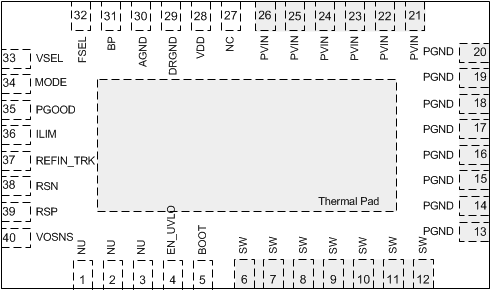SLUSCI8A July 2016 – August 2017 TPS548D21
PRODUCTION DATA.
- 1 Features
- 2 Applications
- 3 Description
- 4 Revision History
- 5 Pin Configuration and Functions
- 6 Specifications
-
7 Detailed Description
- 7.1 Overview
- 7.2 Functional Block Diagram
- 7.3 Feature Description
- 7.4 Device Functional Modes
- 7.5 Programming
-
8 Applications and Implementation
- 8.1 Application Information
- 8.2
Typical Applications
- 8.2.1 TPS548D21 1.5-V to 16-V Input, 1-V Output, 40-A Converter
- 8.2.2 Design Requirements
- 8.2.3
Design Procedure
- 8.2.3.1 Custom Design With WEBENCH® Tools
- 8.2.3.2 Switching Frequency Selection
- 8.2.3.3 Inductor Selection
- 8.2.3.4 Output Capacitor Selection
- 8.2.3.5 Input Capacitor Selection
- 8.2.3.6 Bootstrap Capacitor Selection
- 8.2.3.7 BP Pin
- 8.2.3.8 R-C Snubber and VIN Pin High-Frequency Bypass
- 8.2.3.9 Optimize Reference Voltage (VSEL)
- 8.2.3.10 MODE Pin Selection
- 8.2.3.11 Overcurrent Limit Design.
- 8.2.4 Application Curves
- 9 Power Supply Recommendations
- 10Layout
- 11Device and Documentation Support
- 12Mechanical, Packaging, and Orderable Information
Package Options
Refer to the PDF data sheet for device specific package drawings
Mechanical Data (Package|Pins)
- RVF|40
Thermal pad, mechanical data (Package|Pins)
- RVF|40
Orderable Information
5 Pin Configuration and Functions
RVF Package
40-Pin LQFN-CLIP With Thermal Pad
Top View

Pin Functions
| PIN | I/O/P(1) | DESCRIPTION | |
|---|---|---|---|
| NAME | NO. | ||
| AGND | 30 | G | Ground pin for internal analog circuits. |
| BOOT | 5 | P | Supply rail for high-side gate driver (boot terminal). Connect boot capacitor from this pin to SW node. Internally connected to BP via bootstrap PMOS switch. |
| BP | 31 | O | LDO output |
| DRGND | 29 | P | Internal gate driver return. |
| EN_UVLO | 4 | I | Enable pin that can turn on the DC/DC switching converter. Use also to program the required PVIN UVLO when PVIN and VDD are connected together. |
| FSEL | 32 | I | Program switching frequency, internal ramp amplitude and FCCM mode. |
| ILIM | 36 | I/O | Program overcurrent limit by connecting a resistor to ground. |
| MODE | 34 | I | Mode selection pin. Select the control mode (DCAP3 or DCAP), internal VREF operation, and soft-start timing selection. |
| NC | 27 | No connect. | |
| NU | 1, 2, 3 | O | Not used pins. |
| PGND | 13, 14, 15, 16, 17, 18, 19, 20 | P | Power ground of internal FETs. |
| PGOOD | 35 | O | Open drain power good status signal. |
| PVIN | 21, 22, 23, 24, 25, 26 | P | Power supply input for integrated power MOSFET pair. |
| RSN | 38 | I | Inverting input of the differential remote sense amplifier. |
| RSP | 39 | I | Non-inverting input of the differential remote sense amplifier. |
| REFIN_TRK | 37 | I | System reference voltage that can be overridden by the external voltage source for tracking and sequencing application. |
| SW | 6 , 7, 8, 9, 10, 11, 12 | I/O | Output switching terminal of power converter. Connect the pins to the output inductor. |
| VDD | 28 | P | Controller power supply input. |
| VOSNS | 40 | I | Output voltage monitor input pin. |
| VSEL | 33 | I | Program the initial start-up and or reference voltage without feedback resistor dividers (from 0.6 V to 1.2 V in 50-mV increments). |
(1) I = input, O = output, G = GND